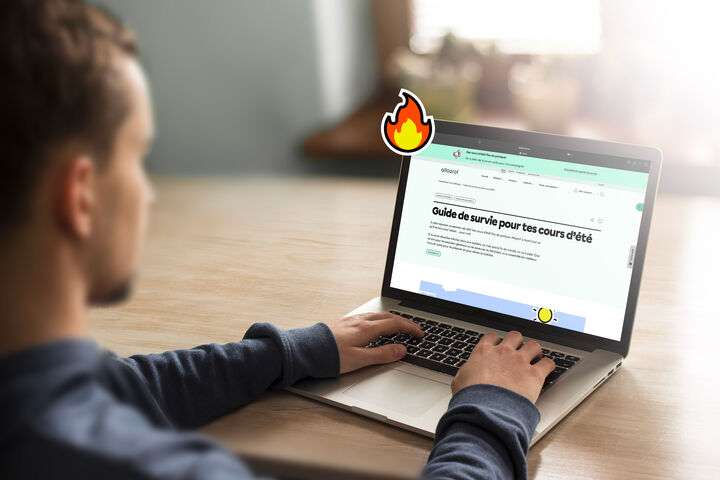Lors de son passage à l’émission « Ça s’explique » à la radio de Radio-Canada le 16 septembre dernier, Serge Gérin-Lajoie, professeur à l’Université TÉLUQ, discute des défis de l’enseignement à distance. Voici un compte-rendu des éléments intéressants à retenir de ses propos, tirés de son entrevue et de ses notes complémentaires.
Enseigner en présentiel et à distance : des similitudes…
Selon M. Gérin-Lajoie, l’enseignement en présentiel et l’enseignement à distance s’appuient sur les mêmes fondements ou la même démarche pédagogique. Dans les deux cas, les élèves doivent atteindre des cibles d’apprentissage et développer leurs compétences par des activités diverses. La vérification de l’atteinte de ces cibles se fera tout au long du processus et à la fin par des activités d’évaluation. Dans l’un ou l’autre des contextes, l’enseignant doit pouvoir se mettre à la place de ses élèves, qui ont tous des bagages de connaissances et d’expériences différents. Son rôle est d’arriver à identifier les besoins, les moyens ainsi que les ressources nécessaires pour permettre aux élèves d’accomplir les apprentissages visés.
En classe comme à distance, l’enseignant doit arriver à identifier les besoins, les moyens ainsi que les ressources nécessaires pour permettre aux élèves d’accomplir les apprentissages visés.
Et de grandes différences!
Là où il y a des différences, c’est qu’en classe, un enseignant peut questionner pour vérifier si les apprenants comprennent, circuler dans les rangées de bureaux pour identifier qui sont ceux qui ont des difficultés, etc. Autrement dit, il peut s’ajuster plus facilement, apporter des compléments d’information, modifier le matériel didactique rapidement, démarrer des discussions impromptues, etc.
À distance, l’enseignement passe par des outils technologiques et numériques, ce qui implique un ajustement majeur des moyens utilisés. Par exemple, dans plusieurs cours, on utilise des livres, des volumes, des notes de cours. Est-ce que ces documents sont suffisamment complets pour permettre aux jeunes de cheminer et de comprendre par eux-mêmes? « Sinon, est-ce que je dois fournir des documents complémentaires? Si oui comment? Par un site Web? Que contiendra-t-il? » précise le professeur du département d’éducation de la TÉLUQ.
« Un autre exemple, dois-je réaliser des vidéos moi-même pour enseigner à distance? Si oui, est-ce que je peux avoir du soutien de personnes plus qualifiées que moi? Quelle est la longueur maximale de la vidéo si je veux que les étudiants restent concentrés? ». Par ailleurs, il y a plusieurs éléments à considérer lorsqu’on utilise une vidéo existante sur Internet. Outre le fait de valider si le contenu est assez complet pour favoriser l’apprentissage, les droits d’auteurs et les droits d’utilisation sont également à vérifier.
M. Gérin-Lajoie termine avec l’exemple d’apprendre aux élèves à faire un graphique. « Est-ce que je leur fais faire à la main? Si oui, comment puis-je arriver à leur faire apprendre à distance? Si je propose aux élèves de le faire sur un ordinateur ou une tablette, comment s’assurer qu’ils ont les applications nécessaires? Savent-ils comment les utiliser? ». Toutes des choses à penser en permanence!
Dans le même sens, les interactions à distance sont médiatisées. On communique par le biais du matériel didactique, mais aussi par courriel, par visioconférence, par message-texte, par le biais d’un forum ou d’un blogue, etc. Enseigner à distance signifie qu’il faut prévoir des canaux de communication qui vont rejoindre les élèves tout autant que de leur permettre de contacter l’enseignant.
L’élève doit être informé des méthodes de travail malgré les difficultés techniques qui peuvent être rencontrées. Enfin, il importe de préparer des messages à envoyer pour soutenir et accompagner les élèves selon leurs besoins, notamment ceux qui éprouvent des difficultés d’apprentissage.
- Pour entendre l’intégralité de l’échange entre Alexis De Lancer et Serge Gérin-Lajoie, rendez-vous sur le site de Radio-Canada.
- La formation « Enseigner à distance » de la TÉLUQ est toujours disponible.
- Pour d’autres outils, on vous invite à lire nos articles sur la transition vers l’enseignement à distance.






